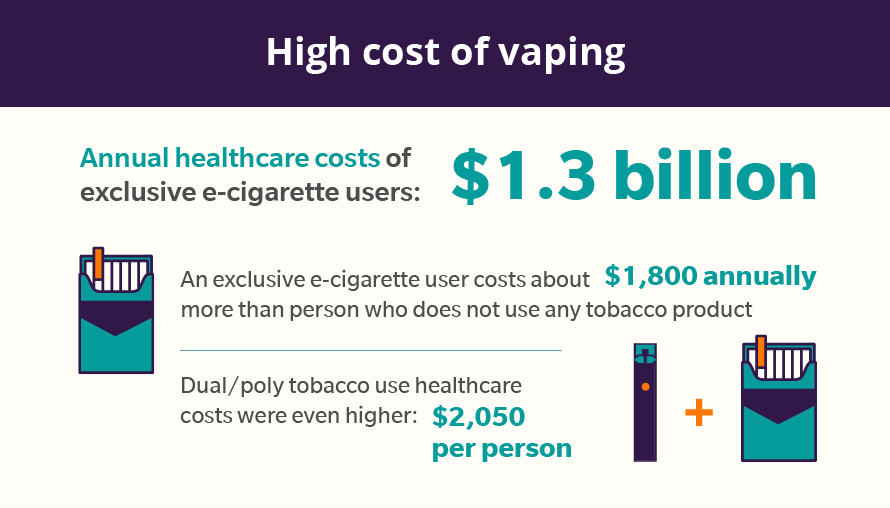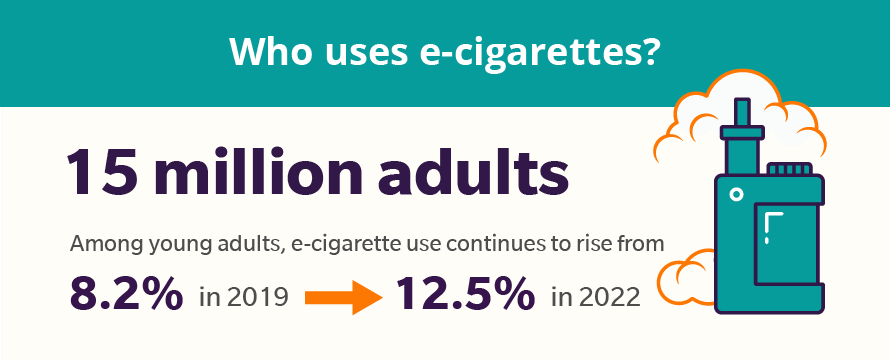Looking to find the real costs of vaping? The answer is different for individuals vs. employers.
Cost of vaping for individuals
In the past few years, disposable e-cigarettes—one of the most used type of e-cigarette—have evolved to be bigger in size and nicotine strength. They have also become dramatically cheaper for individuals.
From January 2020 through September 2022, average unit prices of a vaping device increased from $8.49 to $14.07, while the average price of 1 mL of e-liquid (liquid for use inside an e-cigarette) decreased from $7.96 to $2.45.
In other words, after a minimal investment in a vaping device, an individual can obtain e-liquid refills extremely cheaply.
At the same time, research by the Centers for Disease Control in partnership with Truth Initiative found that the price of e-cigarettes with lower nicotine levels have become more expensive.
Cost of vaping to employers
While vaping has become cheaper for individuals, the costs of vaping to employers and society are quite different. Research published in the journal Tobacco Control provides some of the first evidence of the costs of vaping.
Using national data on nearly 110,000 U.S. insured adults, researchers found that e-cigarette users were more likely to report poor health than never tobacco users. Reported poor health was associated with a higher number of hospital inpatient nights, emergency room visits, doctor visits, and home health visits in the past 12 months.
These excess medical care costs among exclusive e-cigarette users totaled $1.3 billion annually. This equated to roughly $1,800 more per exclusive e-cigarette user compared to a person who doesn’t use any tobacco product. The average excessive medical care costs of dual/poly tobacco use (i.e., smoking and vaping) were even higher, at $2,050 per person.
The authors noted that “despite the lack of understanding of the long-term health impact of e-cigarette use, the contribution of current e-cigarette use to rising healthcare spending is significant and should not be overlooked.”
This excess spending is particularly relevant for employers, who cover over half of Americans through employer-sponsored health insurance.
What are the costs of vaping in the workplace beyond healthcare?
In addition to the financial impact, employee morale and satisfaction are other considerations for employers.
In an EX Program survey on vaping in the workplace, 62% of all respondents reported that vaping in the workplace bothers them, and about the same proportion believe that vaping decreases productivity.
The survey also found about 80% of employees said vape- and smoke-free workplaces are important to them. This means vaping could have a much bigger effect on morale than employers may recognize.
How many people use e-cigarettes?
E-cigarette use among all adults has been relatively stable over the past 5 years at around 4.5%-6.0%, which translates to roughly 15 million adults. Among young adults ages 18-34, however, e-cigarette use continues to rise, from 8.2% in 2019 to 12.5% in 2022.
Are all e-cigarettes the same?
There are thousands of e-cigarette products on the market today. From pod-based systems to disposables to the earlier tank style, e-cigarettes are not all the same. Based on an analysis of US retail sales data, the number of unique e-cigarettes quadrupled from 453 to 2,023 between June 2021 and June 2022.
Importantly, the nicotine strength and volume of nicotine-containing e-liquid in e-cigarettes have increased dramatically in recent years.
Disposable e-cigarettes sold in the U.S. nearly tripled in nicotine strength and quintupled in e-liquid capacity between 2017 and 2022. In 2022, 48 new disposable e-cigarettes with 6% or greater nicotine strength entered the market as well as 18 products with a 20-milliliter capacity—that’s 29X the size of a JUUL pod.
High nicotine e-cigarettes currently dominate the market. Their sales have increased 15-fold, representing just 5% of e-cigarette sales in 2017 to 81% of e-cigarette sales in 2022.
The increasing size and strength of disposable e-cigarettes have resulted in a generation of products with nicotine levels comparable to several cartons of cigarettes.
And it’s important to remember: Nicotine is a highly addictive substance—the higher the concentration, the more likely it is that the user will become addicted.
How the EX Program can help
The EX Program has up-to-date content about the pros/cons of using e-cigarettes based on the latest scientific evidence. For those looking to quit vaping, EX Program provides tailored support to quit through a personalized quit plan for e-cigarettes, community support with peers, live chat support for quitting with EX Coaches, and a customized text message program.
Plus, we offer a robust suite of tools and support to parents of kids who vape to help the entire family reap the benefits of living tobacco-free.
Interested in seeing a demo of how we can engage more of your population in quitting tobacco? Contact us to start a conversation today!







